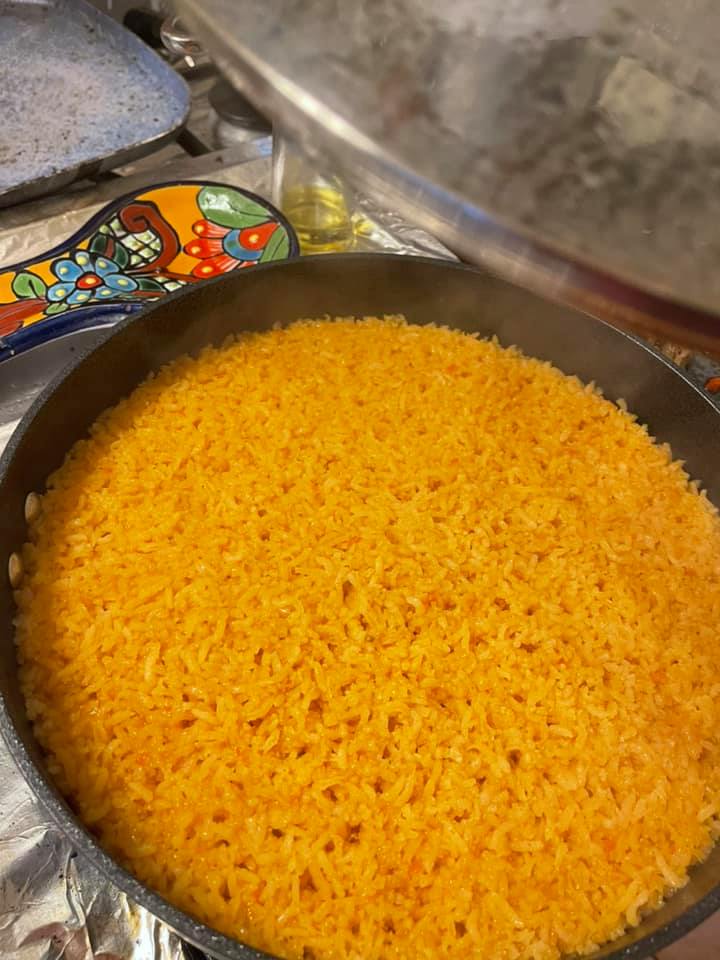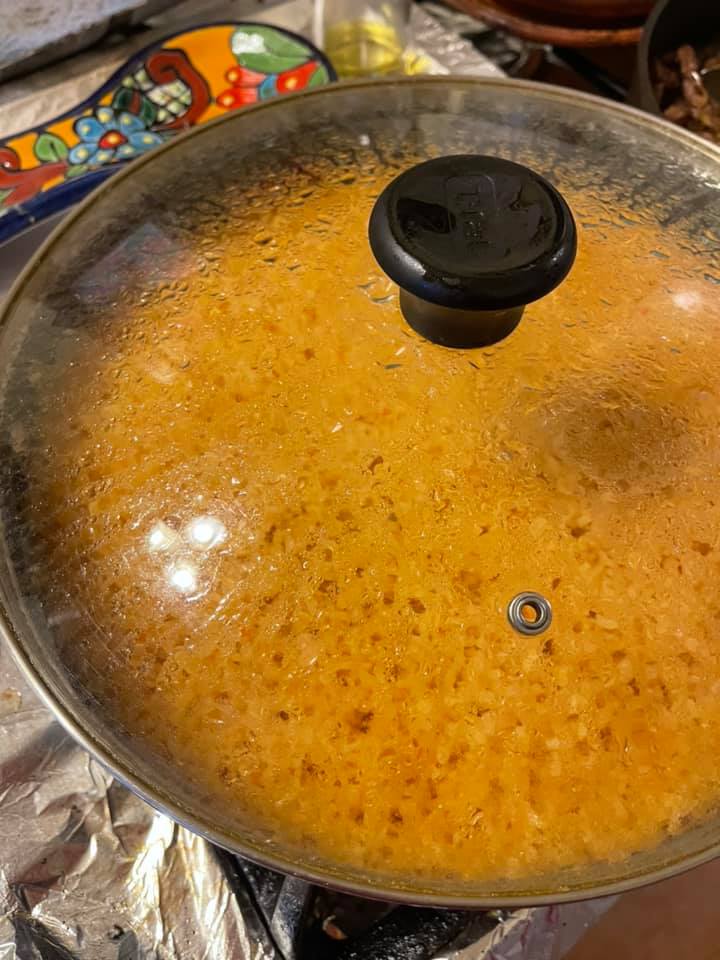Fluffy Spanish Rice
Spanish rice, when made right, is more than just a side dish—it’s the quiet soul of the meal, carrying warmth, depth, and tradition in every tender, fluffy grain.
This version focuses on purity and patience: no canned shortcuts, just fresh tomatoes, fragrant jasmine rice, and a careful process that honors simplicity. Each step, from soaking the rice to letting it rest after cooking, builds not just flavor, but a sense of care. It’s a dish that teaches you to slow down, listen to the sizzle, and wait for the magic.
Perfectly seasoned, never sticky, and delicately infused with tomato and onion, this rice is a humble masterpiece served with love.

Why People Will Love This Fluffy Spanish Rice Recipe:
Authentic flavor rooted in simplicity: Made with fresh tomatoes, onion, and real chicken bouillon, this rice delivers depth of flavor without artificial shortcuts or canned ingredients.
Perfectly light and fluffy texture: The soaking and frying method removes excess starch and toasts the grains, ensuring rice that’s never sticky or mushy—just tender, separate, and beautifully golden.
A mindful cooking process that rewards patience: The step-by-step method invites you to slow down and connect with each stage of the dish, making the outcome more satisfying and meaningful.
Versatile and nourishing: Whether served alongside grilled meats, tacos, or enjoyed on its own, this rice brings warmth and substance to any meal.
A comforting, homemade touch: Unlike packaged or restaurant versions, this rice is full of heart—prepared from scratch with intention, and meant to be shared.
Key Ingredients:
Jasmine rice, known for its delicate aroma and soft texture, is soaked to remove excess starch—this small but essential step transforms the final dish into perfectly fluffy, individual grains that never clump.
Fresh tomatoes bring a bright, natural acidity and sweetness that canned versions can’t match, giving the rice its beautiful red hue and a clean, garden-fresh flavor.
White onion, when blended with the tomatoes, adds a subtle earthiness and depth that forms the aromatic foundation of the dish.
Chicken bouillon (powder or cube) infuses the rice with a rich, savory backbone—its concentrated flavor elevates the entire dish with warmth and umami.
Cooking oil plays a crucial role in toasting the rice, giving it a slightly nutty taste and that signature golden-tan color before the liquids are added.
Salt and water, though simple, are used with intention—to balance and bind the natural flavors together into a harmonious, comforting bowl of rice.
Expert Tips:
Soak with purpose, not just time: Soaking the jasmine rice in cold water for 20 minutes isn’t optional—it removes surface starch, preventing stickiness and allowing each grain to cook up light, tender, and distinct.
Fry the rice slowly and evenly: Don’t rush this step. Toasting the rice in oil until it turns a light tan color enhances its nutty aroma and sets the foundation for flavor and texture. Stir constantly to ensure even browning without burning.
Use fresh, ripe tomatoes only: Fresh tomatoes contain natural sugars and acidity that balance perfectly with the savory bouillon. Avoid canned versions—they can add a metallic or overly concentrated taste that dulls the freshness.
Blend ingredients thoroughly: Make sure the tomatoes, onion, bouillon, salt, and water are fully blended into a smooth sauce. Any chunks can lead to uneven flavor distribution in the rice.
Respect the timing and resting period: Once the rice simmers for 20 minutes, do not lift the lid. Let it sit off the heat, covered, for 10 full minutes. This final rest allows the steam to finish cooking the rice gently and evenly, creating that signature fluffy texture.
Adjust water for altitude and pot type: If you live at a higher altitude or use a thinner-bottomed pan, your cooking time and water absorption may vary slightly. Trust your experience, and make small adjustments if needed.

How to make Fluffy Spanish Rice
1 cup of Jasmine Rice ( soak it in Cold Water for 20 min and drain it , this is to eliminate the starch and your rice will not stick or be mushy
Blend :
2 fresh tomatoes ( i do not use anything in can)
1/4 Of a white Onion
2 spoon full of Chicken bullion / or 2 cubes
Salt to taste
And 1/2 cup of water
Drain the rice and fry it with oil
Tilll the rice changes to a tan color
Add the ( blend )
And wait till it boils
Add 2 cups of water and put the lid on
And cook it in a medium/low for 20 min (only)
(Really use your timer )
After 20 min passed turn it off ( do not open the lid) let it sit for 10 min
Enjoy!

Important Notes When Making Fluffy Spanish Rice:
The quality of rice matters: Use high-quality jasmine rice for its natural fragrance and light, fluffy texture. Avoid short-grain or sticky rice varieties—they will not yield the same results.
Toasting is not just for color—it’s for flavor: Frying the rice until tan enhances both aroma and taste. This step adds depth and ensures the rice won’t turn mushy when liquid is added.
Fresh ingredients create honest flavor: Using fresh tomatoes and onions (not canned or pre-chopped) honors the authenticity of the dish and produces a naturally bright, clean-tasting base.
Chicken bouillon is your umami anchor: It’s the bridge between simple vegetables and rich, savory flavor. Choose a good brand, and taste before adding extra salt—some bouillons are already salty enough.
Lid discipline is essential: Once the rice is simmering, resist the urge to lift the lid. Keeping the steam trapped ensures even cooking. The 10-minute resting time afterward is just as critical—it finishes the cooking process and helps set the texture.
This recipe is a method, not just a dish: The steps here are rooted in tradition and patience. Each one builds toward rice that is not only delicious, but full of care and intention.
How To Enjoy Fluffy Spanish Rice After Cooking:
Let It Rest Fully Before Serving
After the final 10-minute resting period (with the lid still on), gently fluff the rice with a fork—never a spoon. This preserves the airy texture and separates the grains without crushing them.
Serve It as a Star or Side
This rice is versatile. It can stand alone as a light, satisfying meal with avocado and lime wedges, or serve as a base for grilled meats, roasted vegetables, or saucy dishes like chicken tinga or carne guisada.
Garnish with Intention
Add chopped cilantro, a drizzle of lime juice, or a few slices of fresh jalapeño to brighten the flavor. These small touches create contrast and keep the rice tasting fresh and vibrant.
Pair with Complementary Textures
The rice’s softness and light chew go beautifully with crispy tacos, seared proteins, or crunchy slaw. Think of it not just as a side, but as part of a texture symphony on your plate.
Savor It Slowly
Let the warmth of the rice, the savory broth notes, and the faint tomato sweetness unfold in each bite. This dish was made with patience—so enjoy it with the same mindfulness.
Store and Reheat Properly
If you have leftovers, store in an airtight container once fully cooled. To reheat, sprinkle with a bit of water and steam in a covered pan or microwave gently—this restores moisture and prevents drying out.

Nutrition Information:
Per serving (1 of about 4 servings) for the Fluffy Spanish Rice recipe, presented in your requested format:
Calories: 185 kcal | Total Fat: 4.2 g | Saturated Fat: 0.7 g | Monounsaturated Fat: 2.1 g | Polyunsaturated Fat: 1.1 g | Cholesterol: 0 mg | Sodium: 480–600 mg (depending on bouillon and salt used) | Total Carbohydrates: 32.4 g | Dietary Fiber: 1.6 g | Sugars: 2.8 g | Protein: 3.2 g
Frequently Asked Questions:
Why do I need to soak the rice before cooking?
Soaking removes excess surface starch from the jasmine rice, which prevents it from becoming sticky or mushy during cooking. This step also helps the grains cook more evenly and absorb flavor more effectively.
Can I use a different type of rice instead of jasmine?
You can, but results will vary. Long-grain white rice is the closest substitute. Avoid short-grain or sticky rice, as they tend to clump and won’t yield the fluffy texture this recipe is known for.
What if I don’t have fresh tomatoes? Can I use canned ones?
Fresh tomatoes are preferred for their natural sweetness and clean flavor, but in a pinch, you can use whole peeled canned tomatoes—just be sure to drain them well and adjust seasoning, as canned tomatoes may be more acidic or salty.
My rice turned out too wet—what went wrong?
It may not have simmered long enough, or the lid was removed too early. Always use a timer, cook on low heat, and resist lifting the lid. Allowing it to sit undisturbed for 10 minutes after cooking is essential to steam off excess moisture.
Can I double this recipe for a larger group?
Yes, but make sure to use a wider, heavy-bottomed pot with a tight-fitting lid. Keep the rice in a relatively shallow layer to ensure even cooking. The timing may increase slightly, so watch the texture and don’t skip the resting period.
Why is it important to fry the rice before adding liquid?
Frying the rice in oil until golden tan helps develop a toasty, nutty flavor and locks in texture. It creates a protective coating around each grain, preventing them from breaking down or sticking together during cooking.
How do I know when the rice is properly toasted?
Look for a uniform light golden-tan color and a fragrant, nutty aroma. Stir frequently during this step to ensure even browning and avoid burning, which can create bitter notes in the final dish.
What’s the best way to blend the tomato mixture?
Use a high-speed blender or food processor to ensure a smooth, even sauce. A well-blended tomato base distributes flavor more consistently and cooks down into the rice beautifully without leaving chunks.
Can I open the lid while the rice is cooking or resting?
No—keep the lid on tight! Opening the lid releases essential steam, which disrupts the cooking process. Wait the full 20 minutes for cooking and 10 minutes for resting before checking the texture.
How can I prevent the rice from burning or sticking to the bottom?
Use a heavy-bottomed pan and keep the heat at medium-low once the final water is added. Stir well after adding the blended mixture and again after pouring in water, then leave it undisturbed to allow even, gentle cooking.